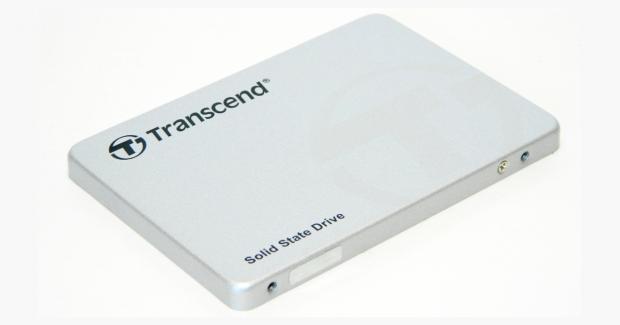The Bottom Line
Introduction, Drive Specifications, Pricing and Availability
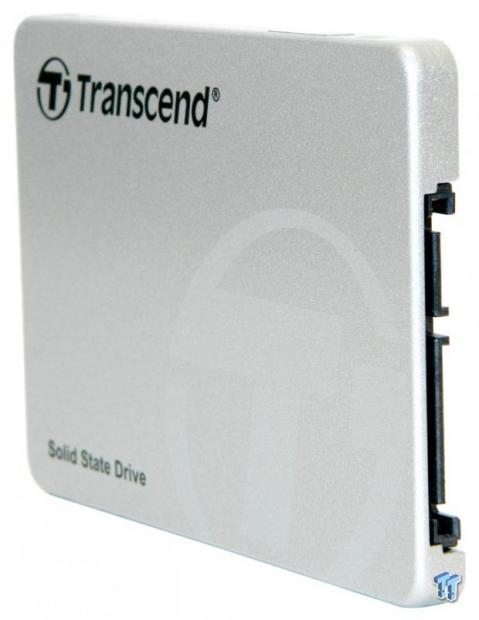
Transcend is a company with a broad portfolio of consumer electronic products ranging from memory cards to body cameras. The SSD370S or 370S as we will refer to it going forward is Transcend's premium SSD product. The drive is powered by a Silicon Motion 2246EN four-channel controller. Despite only four channels, the SMI 2246EN is capable of delivering excellent performance when paired with quality flash. This is why the SMI 2246EN has become today's most prolific third-party SSD controller.
On the flash side, Transcend lets us know that the drive sports an MLC flash array, which we like. We approached Transcend as to the brand of flash they are using because the flash packages utilized are not branded. Transcend chose not to disclose the brand of flash they are using, but we have a pretty good idea. It's 16nm, it's synchronous, so that narrows the field down to Micron. Update: Transcend contacted us after publishing the review and informed us they are packaging their flash in-house using genuine Micron 16nm wafers.
The 370S 512GB SATA III SSD ships as a complete package upgrade for HDD users. Included is a 3.5" to 2.5" adapter and downloadable cloning software, making the transition from a 3.5" HDD to a 2.5" SSD easy for first timers. The 370S 512GB SATA III 2.5" SSD is currently retailing for $180 at Amazon.
Specifications: Transcend SSD370S 512GB SATA III SSD
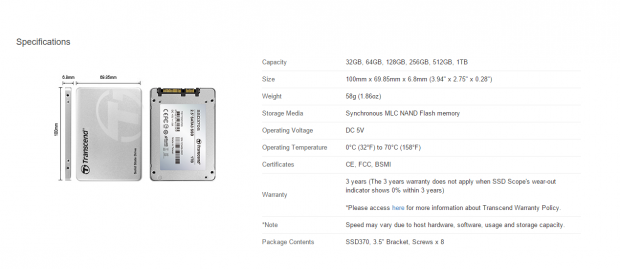
The 370S SATA III 2.5" x 7mm FF SSD is available in six capacities: 32GB, 64GB, 128GB, 256GB, 512GB and 1TB. We could not find any performance specifications for the 370S at Transcend's website, but we did find performance specifications given for the 1TB model on the back of the drives packaging. The performance of the 1TB model is listed at 560 MB/s sequential read, 460 MB/s sequential write. Random performance is listed at 75,000 IOPS for both read and write. Transcend backs the 370S with an industry standard three-year warranty. No TBW is given, but one is implied.
Drive Details
Transcend SSD370S 512GB SATA III SSD
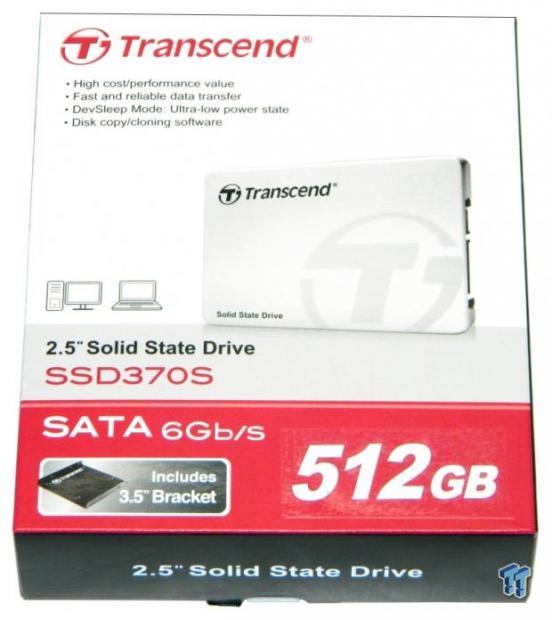
The S370 retails in red, black and white colored packaging. The front of the box features an image of the enclosed drive and included adapter bracket. Downloadable cloning software is advertised as well.
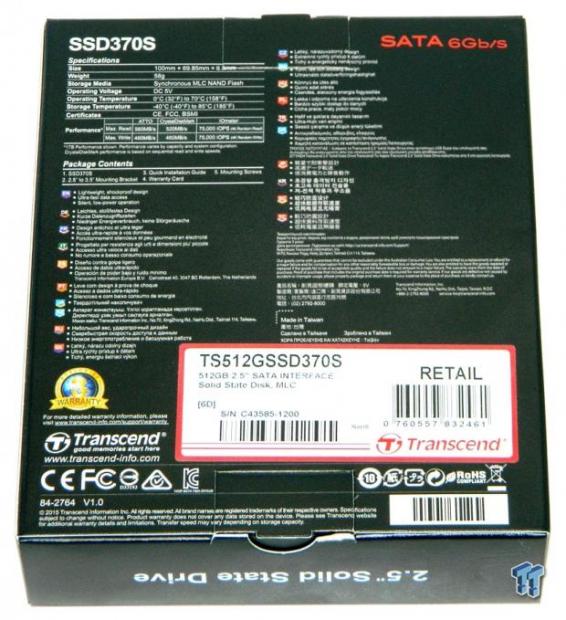
The rear of the packaging lists the drive's performance capabilities at the 1TB capacity point, along with the drive's model number and capacity.

Contained within the packaging is the drive itself, an adapter bracket, mounting screws, warranty card, quick install guide, and several printed advertisements for other Transcend products.
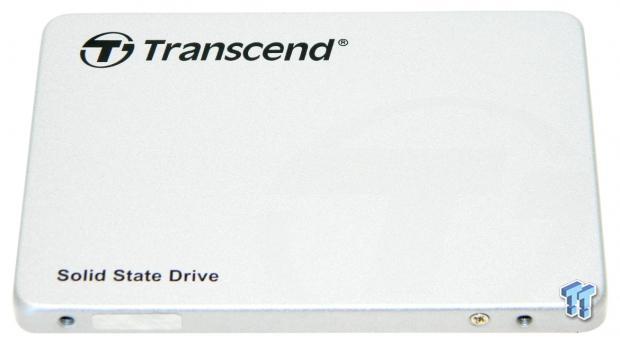
The front of the drive's natural colored aluminum enclosure is minimalistic and attractive.
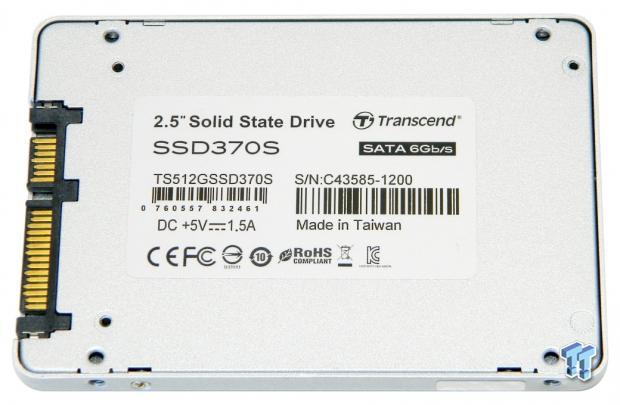
The back half of the drive's aluminum enclosure has manufacturer's label that lists the drive's model number, serial number, and other relevant information.

The drive's full-length PCB is attached to the bottom of the drive's aluminum enclosure with three screws and a locator pin.
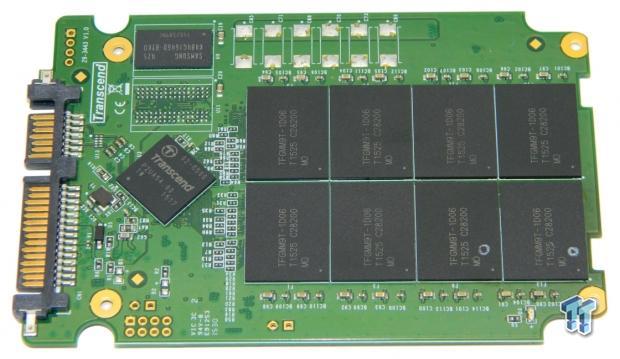
The drive's SM2246EN controller, eight of the drives 16 flash packages, and DRAM cache package are located on this side of the full-length PCB.
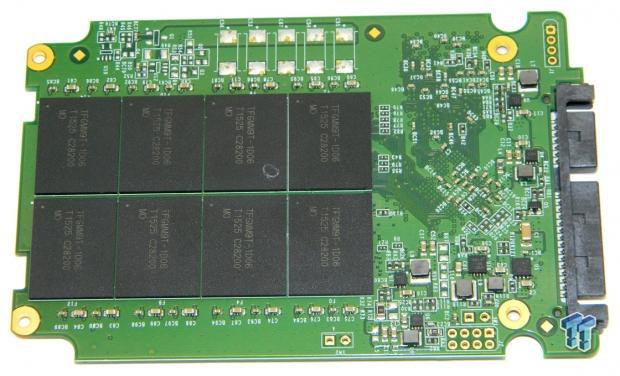
This side of the PCB houses the remaining eight 32GB BGA flash packages.
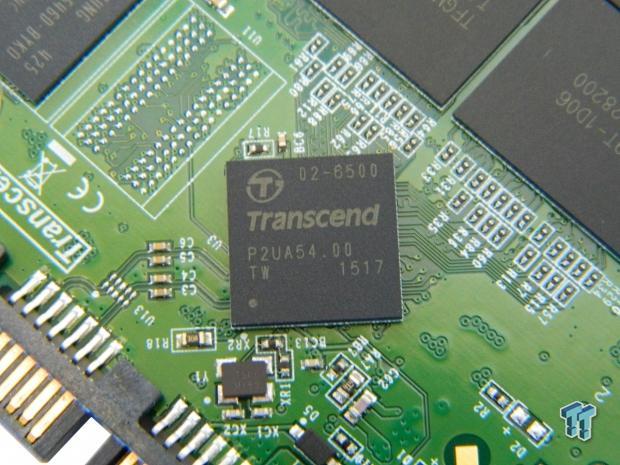
A close-in view of the drive's Transcend branded four-channel Silicon Motion SM2246EN controller that powers the S370.
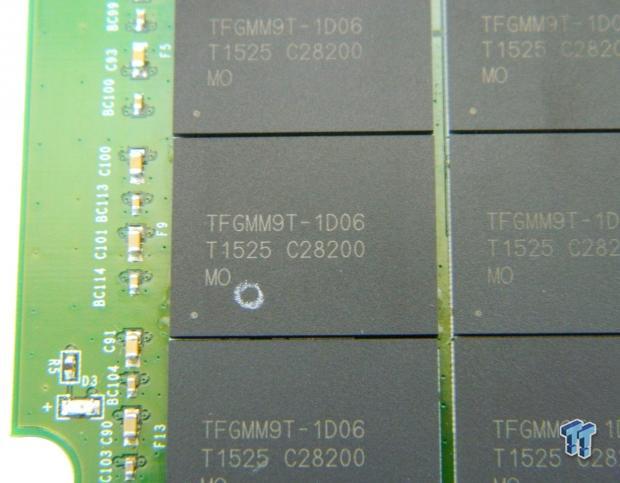
A close-in view of the drive's unbranded flash packages.
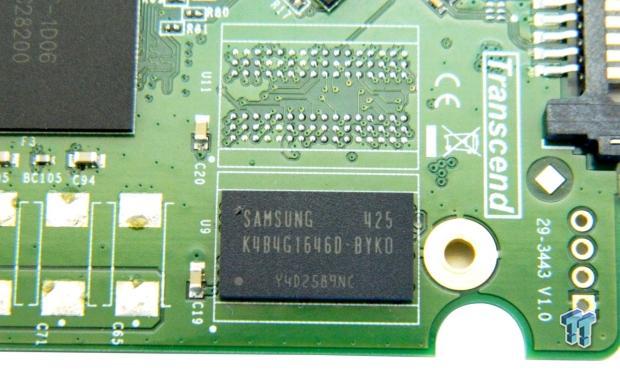
A close-in view of the drive's 512MB Samsung DDR DRAM cache package.
Test System Setup and Properties
Jon's Consumer SSD Review Test System Specifications
- Motherboard: ASRock Extreme9 Z97 - Buy from Amazon
- CPU: Intel Core i7 4790K @ 4.8GHz - Buy from Amazon / Read our review
- Cooler: Swiftech H2O-320 Edge - Buy from Amazon / Read our review
- Memory: Corsair Dominator DDR3 32GB 2400MHz - Buy from Amazon
- Video Card: Onboard Video
- Case: IN WIN X-Frame - Buy from Amazon / Read our review
- Power Supply: Seasonic Platinum 1000 Watt Modular - Buy from Amazon / Read our review
- OS: Microsoft Windows 10 Professional 64-bit - Buy from Amazon
- Drivers: Intel RAID option ROM version 13.0.0.2075 and Intel RST driver version 13.6.0.1002
We would like to thank ASRock, Crucial, Intel, Corsair, RamCity, IN WIN, and Seasonic for making our test system possible.
Drive Properties
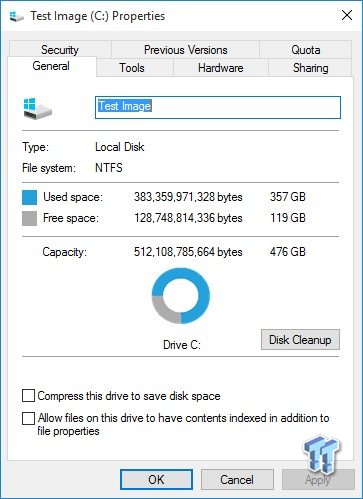
The majority of our testing is performed with our test drive as our boot volume. Our boot volume is 75% full for all OS Disk "C" drive testing to replicate a typical consumer OS volume implementation. We feel that most of you will be utilizing your SSDs for your boot volume and that presenting you with results from an OS volume is more relevant than presenting you with empty secondary volume results.
System settings: Cstates and Speed stepping are both disabled in our systems BIOS. Windows High-Performance power plan is enabled. Windows write caching is enabled, and Windows buffer flushing is disabled. We are utilizing Windows 10 Pro 64-bit OS for all of our testing except for our MOP (Maxed-Out Performance) benchmarks where we switch to Windows Server 2008 R2 64 Bit.
Synthetic Benchmarks - ATTO & Anvil Storage Utilities
ATTO
Version and / or Patch Used: 2.47
ATTO is a timeless benchmark used to provide manufacturers with data used for marketing storage products.
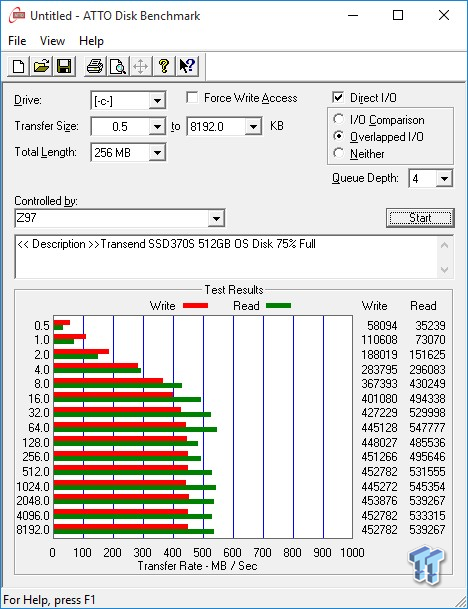
Sequential read/write transfers max out at 547/452 MB/s. Keep in mind this is our OS volume 75% full. This is a little lower than we typically see from SM2246EN controlled drives with tier 1 flash, but still very acceptable.
Sequential Write
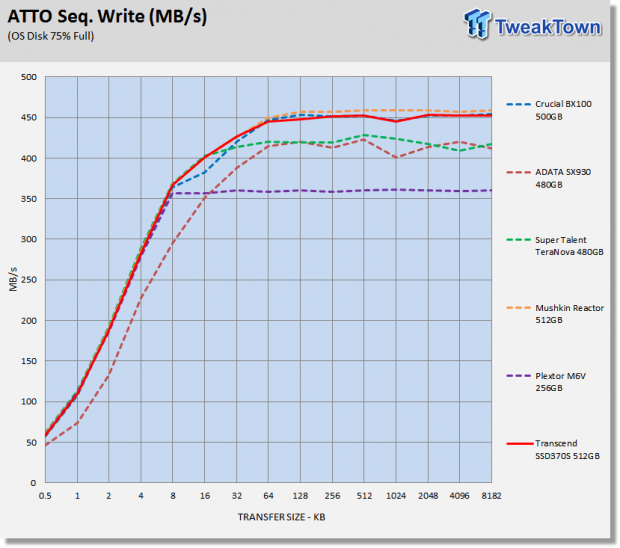
The 370S has good low-end performance ramping up quickly. The 370S takes the lead at 16KB-32KB transfers and levels off just below Mushkin's Reactor.
Sequential Read
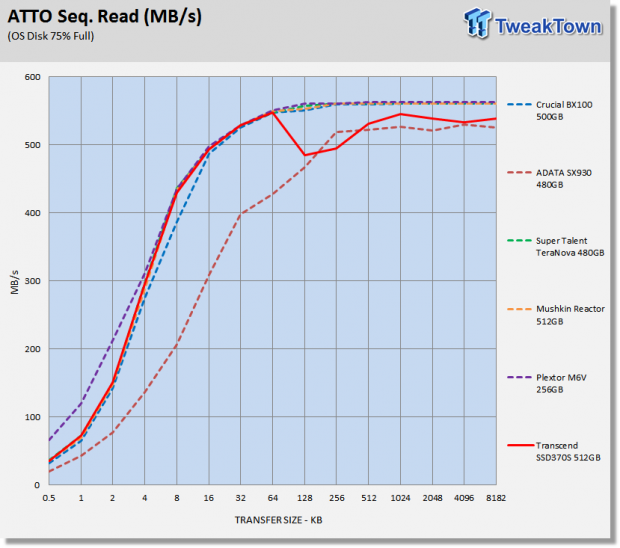
The 370S holds its own up to 64KB transfers, after that, the other 2246EN powered drives with tier one flash outperform it.
Anvil Storage Utilities
Version and / or Patch Used: 1.1.0
Anvil's Storage Utilities is a storage benchmark designed to measure the storage performance of SSDs. The Standard Storage Benchmark performs a series of tests; you can run a full test or just the read or write test, or you can run a single test, i.e. 4k QD16.
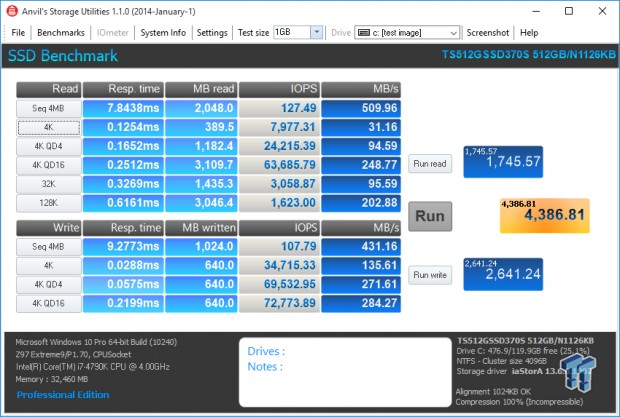
Scoring
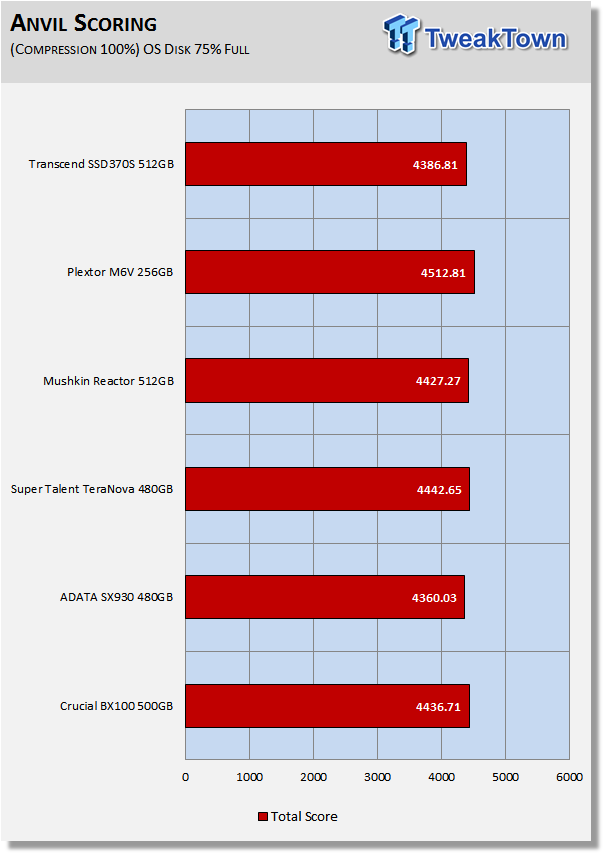
Anvil's scoring gives a good indication of a drive's overall performance. Of the 2246EN powered drives, the 370S scores the lowest.
(Anvil) Read IOPS through Queue Depth Scale

Transcend's 370S performs near the bottom of the test pool, but it does manage to outperform Mushkin's Reactor.
(Anvil) Write IOPS through Queue Scale
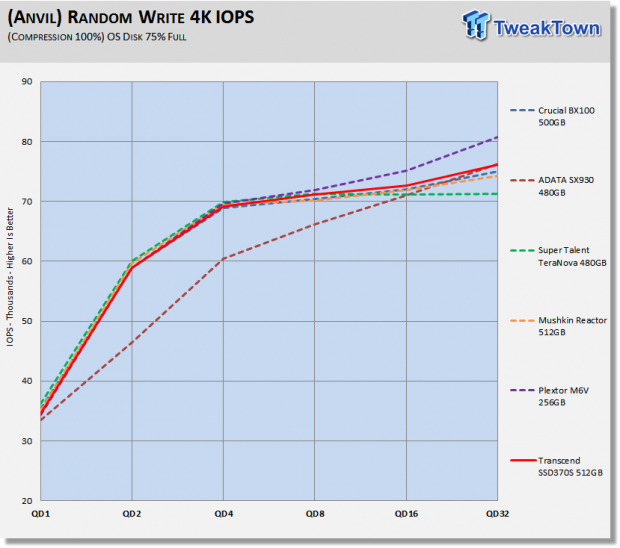
At queue depths of 1-4, the 370S is slightly outperformed by all but the JMicron controlled SX930. From QD8 on up to QD32, the 370S is able to best all but Plextor's 15nm Toshiba MLC powered M6V.
Synthetic Benchmarks - CrystalDiskMark & AS SSD
CrystalDiskMark
Version and / or Patch Used: 3.0 Technical Preview
CrystalDiskMark is disk benchmark software that allows us to benchmark 4k and 4k queue depths with accuracy. Note: Crystal Disk Mark 3.0 Technical Preview was used for these tests since it offers the ability to measure native command queuing at QD4.
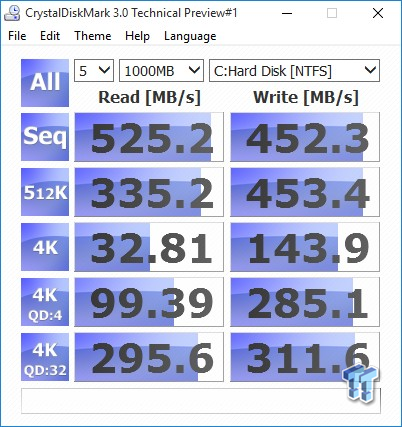
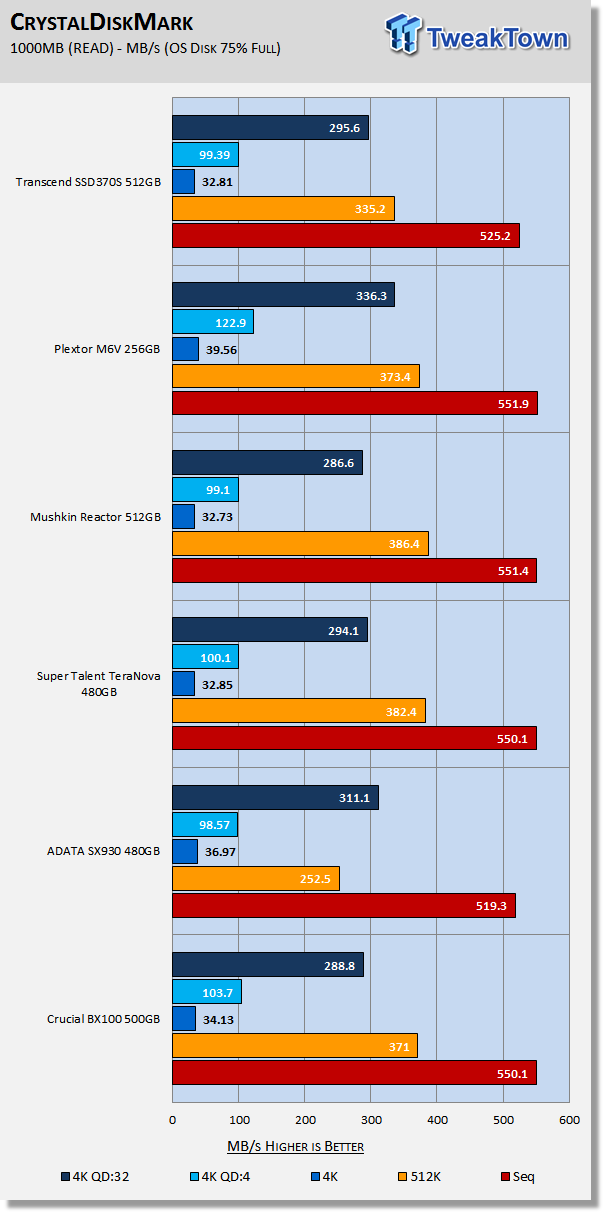
The 370S gives up a little sequential and 512K read performance in comparison to the other 2246EN powered drives in our test pool. The 370S still performs quite well, totally acceptable by our standards.
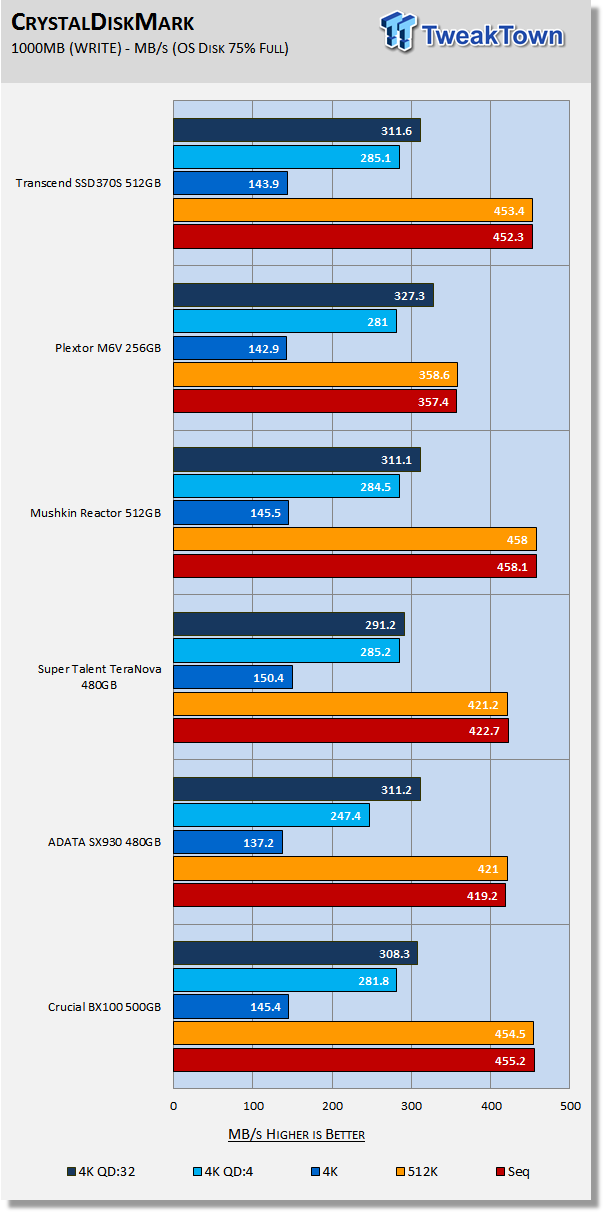
When it comes to write performance, the 370S isn't giving up any ground to the rest of the drives in our test pool; it performs nearly identical to Crucial's BX100.
AS SSD
Version and / or Patch Used: 1.7.4739.38088
AS SSD determines the performance of Solid-State Drives (SSD). The tool contains four synthetic as well as three practice tests. The synthetic tests are to determine the sequential and random read and write performance of the SSD.
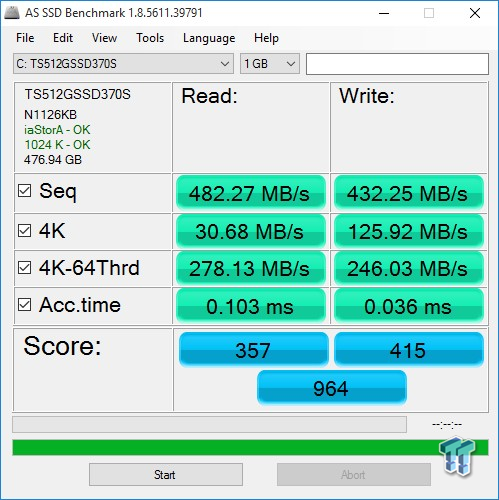
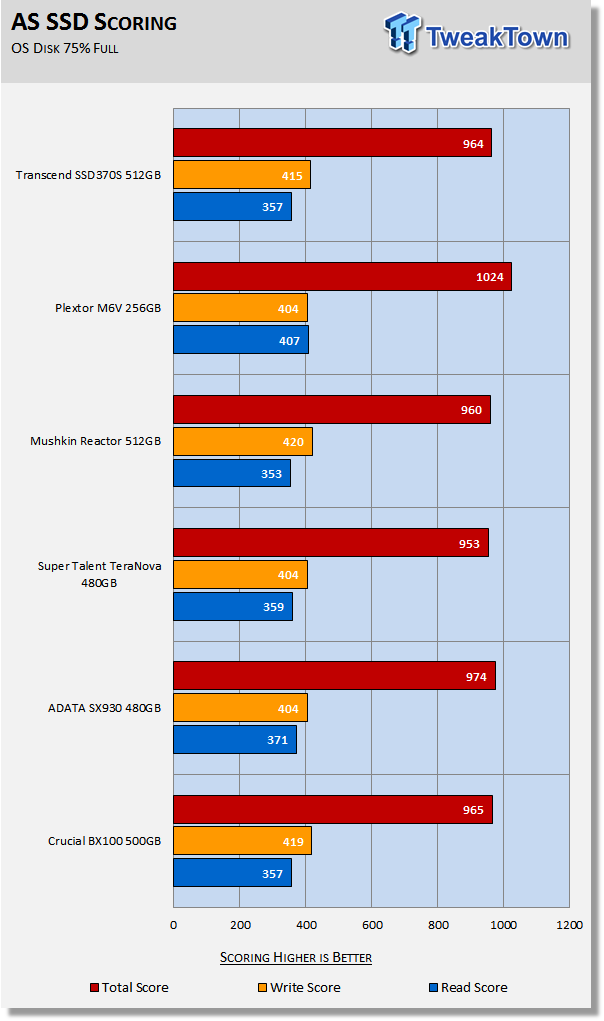
All of the SM2246EN controlled drives score about the same except the M6V. The M6V employs Toshiba 15nm MLC flash, which delivers better write performance than Micron 16nm, giving it a higher score than the rest.
Benchmarks (Trace-Based OS Volume) - PCMark Vantage, PCMark 7 & PCMark 8
Moderate Workload Model
We categorize these tests as indicative of a moderate workload environment.
PCMark Vantage - Hard Disk Tests
Version and / or Patch Used: 1.2.0.0
The reason we like PCMark Vantage is because the recorded traces are played back without system stops. What we see is the raw performance of the drive. This allows us to see a marked difference between scoring that other trace-based benchmarks do not exhibit. An example of a marked difference in scoring on the same drive would be empty vs. filled vs. steady state.
We run Vantage three ways. The first run is with the OS drive 75% full to simulate a lightly used OS volume filled with data to an amount we feel is common for most users. The second run is with the OS volume written into a "Steady State" utilizing SNIA's guidelines. Steady state testing simulates a drives performance similar to that of a drive that been subjected to consumer workloads for extensive amounts of time. The third run is a Vantage HDD test with the test drive attached as an empty, lightly used secondary device.
OS Volume 75% Full - Lightly Used
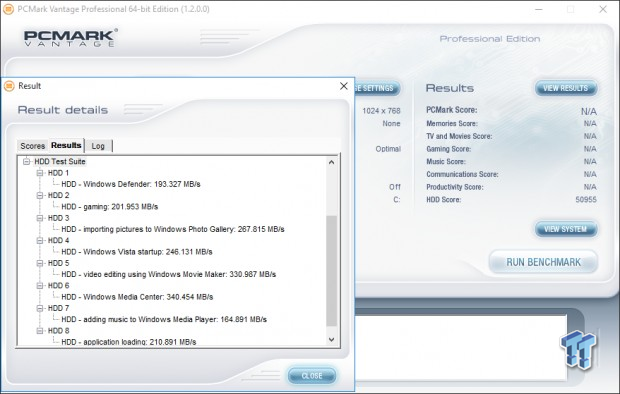
OS Volume 75% Full - Steady State
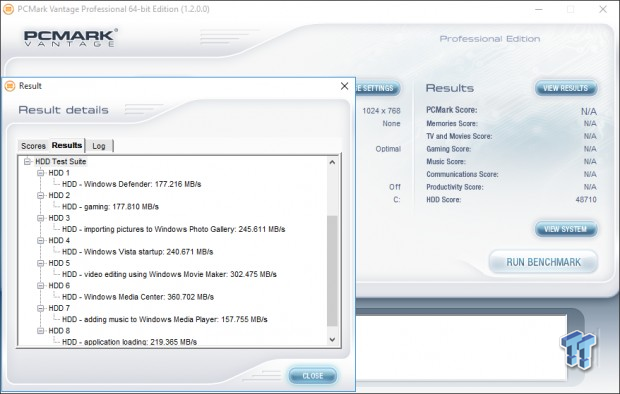
Secondary Volume Empty - FOB
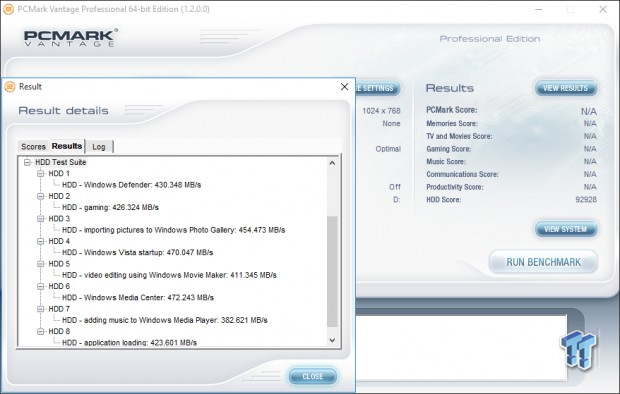
There's a big difference between an empty drive, one that's 75% full/used, and one that's in a steady state.
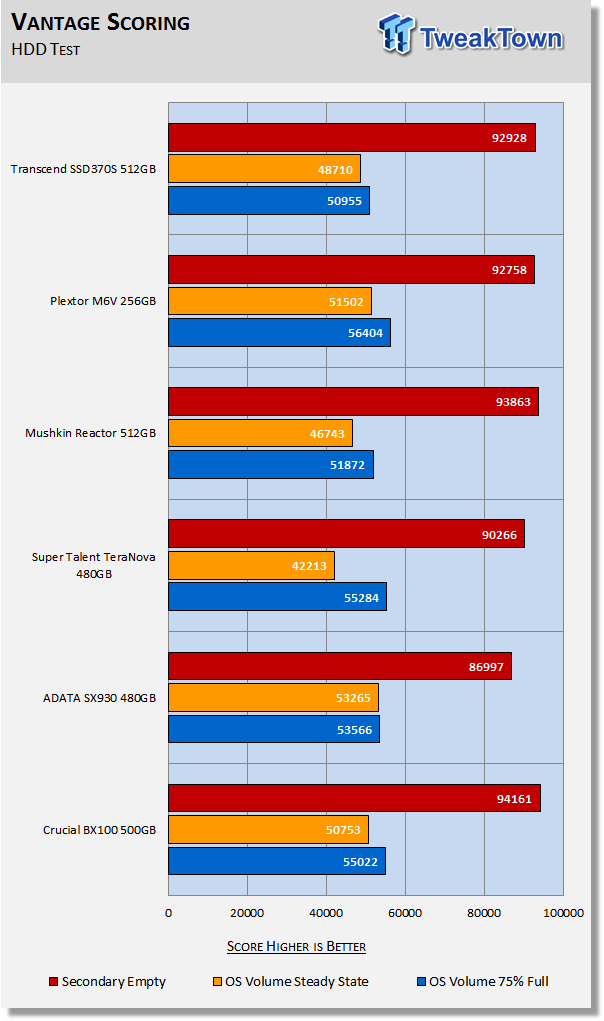
The important scores to pay attention to are "OS Volume Steady State" and "OS Volume 75% full." These two categories are most important because they are indicative of typical of consumer user states. When a drive is in a steady state, it means garbage collection is running at the same time it's reading/writing. This is exactly why we focus on steady state performance.
Empty secondary scoring is almost meaningless, so let's focus on steady state performance. The 370S is able to outperform the similarly configured Reactor and 20nm equipped TeraNova in a steady state.
PCMark 7 - System Storage
Version and / or Patch Used: 1.4.0
We will look to Raw System Storage scoring for evaluation because it's done without system stops and, therefore, allows us to see significant scoring differences between drives.
OS Volume 75% Full - Lightly Used
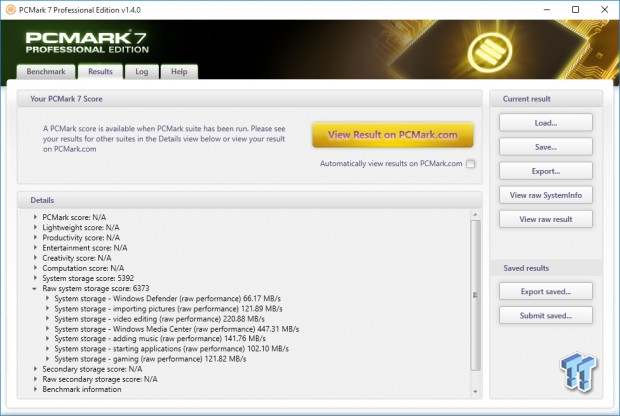
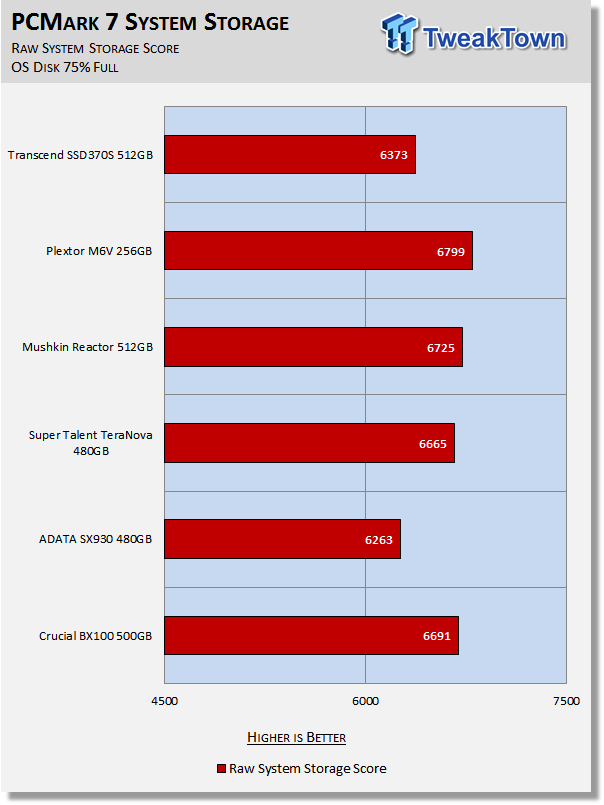
The 370S is outperformed by the similarly configured drives in our test pool, but comes out ahead of ADATA's SX930.
PCMark 8 - Storage Bandwidth
Version and / or Patch Used: 2.4.304
We use PCMark 8 Storage benchmark to test the performance of SSDs, HDDs, and hybrid drives with traces recorded from Adobe Creative Suite, Microsoft Office, and a selection of popular games. You can test the system drive or any other recognized storage device, including local external drives. Unlike synthetic storage tests, the PCMark 8 Storage benchmark highlights real-world performance differences between storage devices.
OS Volume 75% Full - Lightly Used
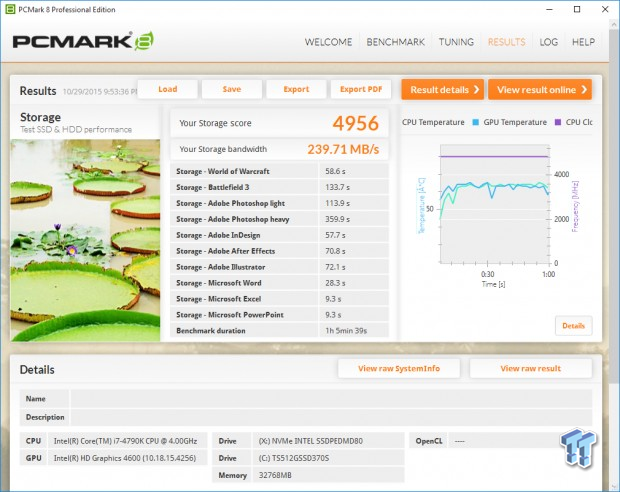
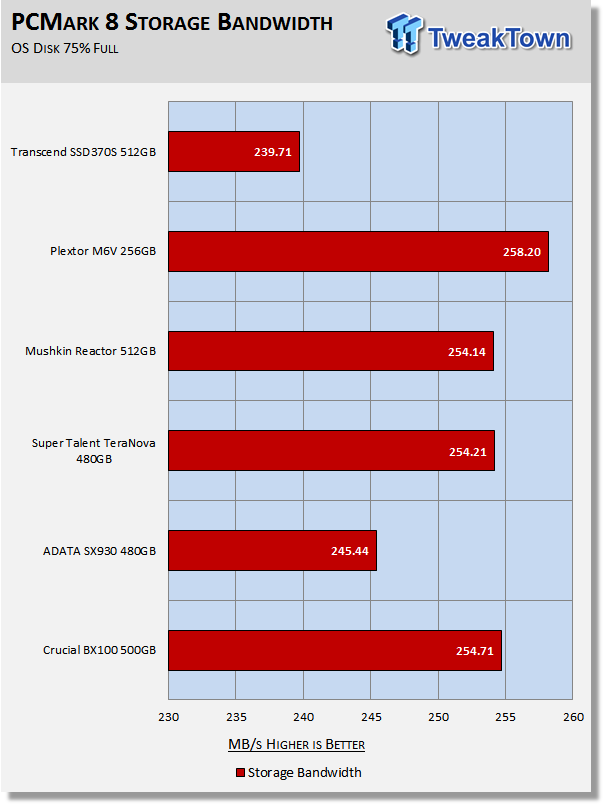
PCMark 8 is the most intensive moderate workload simulation we run. On moderate workloads, this test is what we consider the best indicator of a drives performance. The 370S performs at the bottom of our test pool. The difference between first and last is a mere 19 MB/s, not a big difference, but overall the S370 consistently scores a little lower than the competition.
Benchmarks (Secondary Volume) - Max IOPS, Disk Response & Transfer Rates
Iometer - Maximum IOPS
Version and / or Patch Used: Iometer 2014
We use Iometer to measure high queue depth performance. (No Partition)
Max IOPS Read
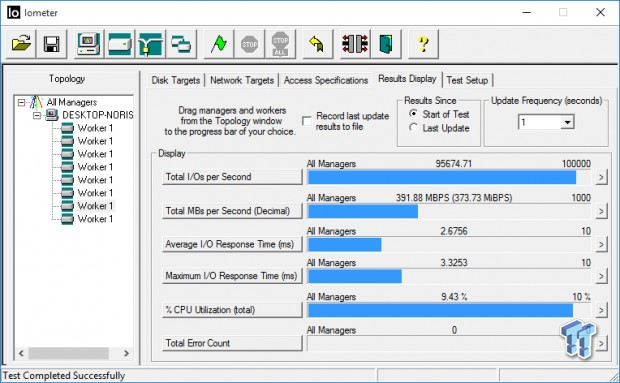
Max IOPS Write
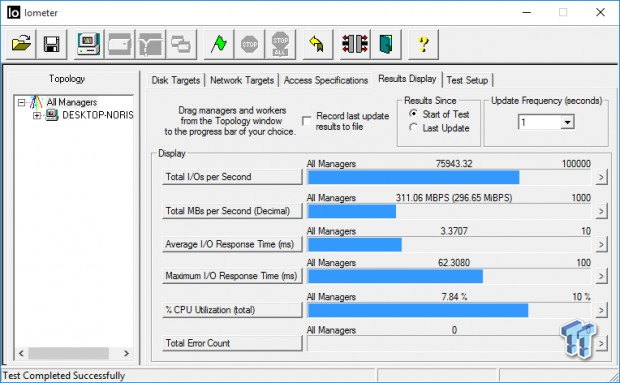
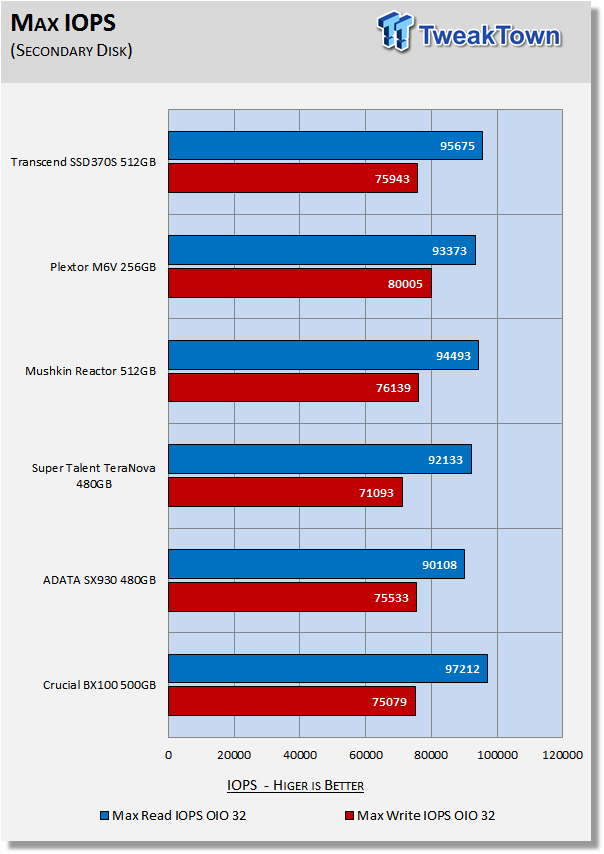
Regarding maximum IOPS, the 370S performs quite well, delivering the second highest read IOPS and third highest write IOPS of the drives in our test pool.
Iometer - Disk Response
Version and / or Patch Used: Iometer 2014
We use Iometer to measure disk response times. Disk response times are measured in an industry accepted standard of 4K QD1 for both write and read. Each test runs twice for 30 seconds consecutively, with a 5-second ramp-up before each test. We partition the drive/array as a secondary device for this testing.
Avg. Write Response
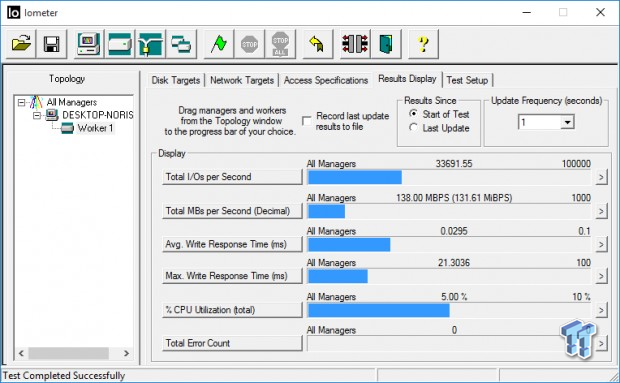
Avg. Read Response
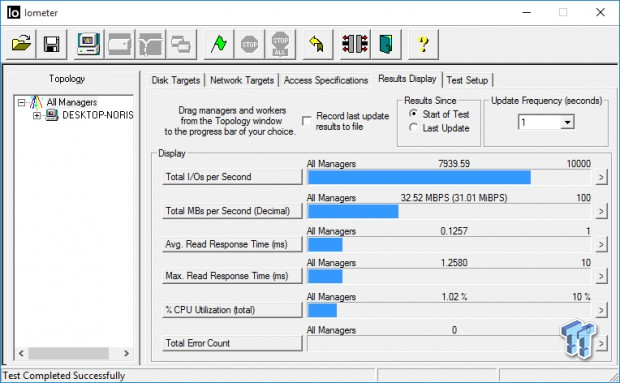
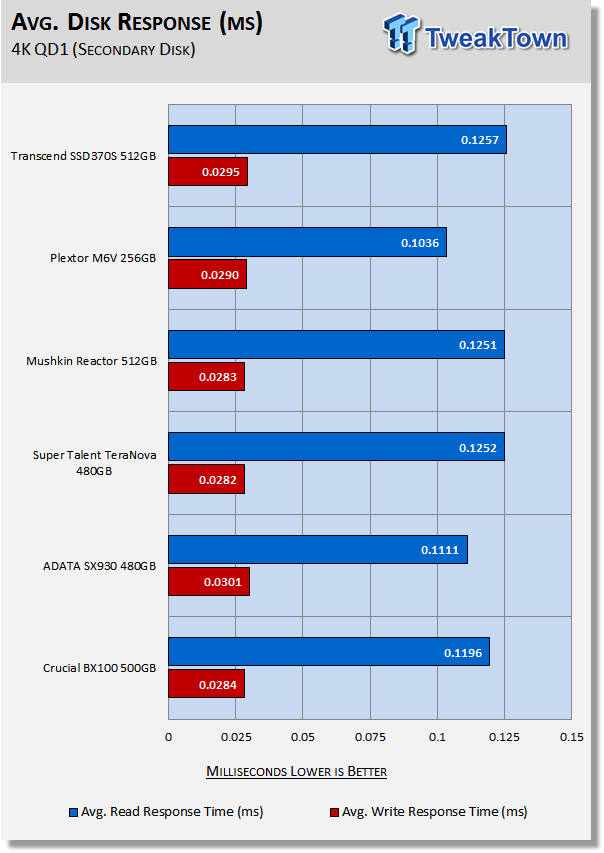
There isn't a whole lot separating the drives in our test pool. The 370S has the highest read latency and second highest write latency of the bunch.
DiskBench - Directory Copy
Version and / or Patch Used: 2.6.2.0
We use DiskBench to time a 28.6GB block (9,882 files in 1,247 folders) composed primarily of incompressible sequential and random data as it's transferred from our DC P3700 PCIe NVME SSD to our test drive. We then read from a 6GB zip file that's part of our 28.6GB data block to determine the test drives read transfer rate. Our system is restarted before the read test to clear any cached data, ensuring an accurate test result.
Write Transfer Rate

Read Transfer Rate
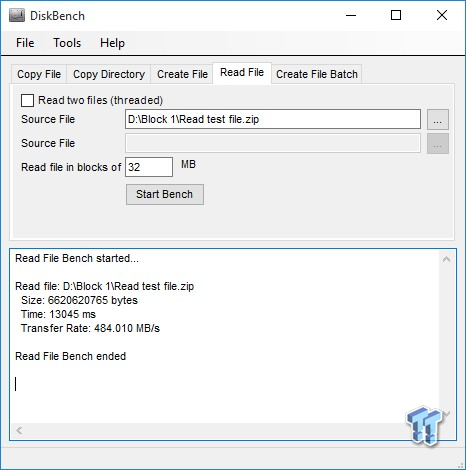
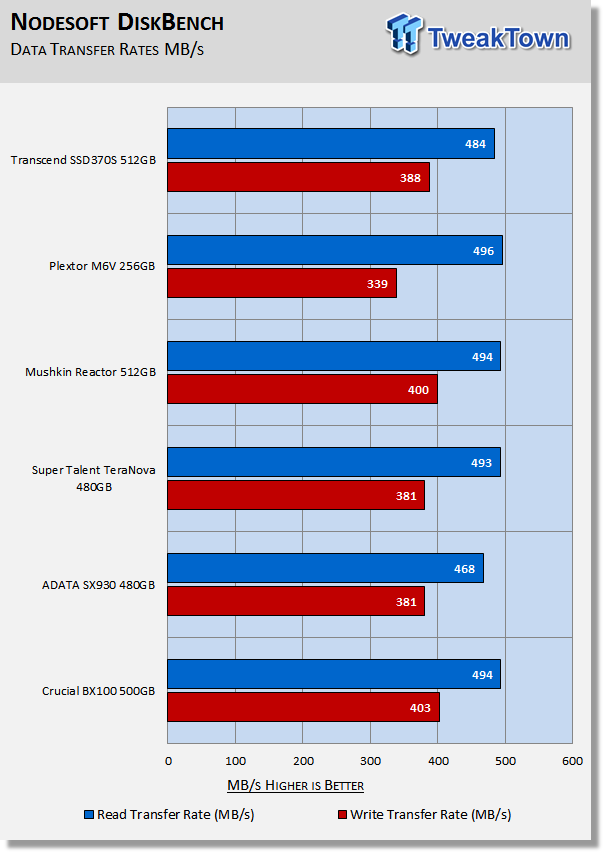
Regarding transfer rates, the 370S delivers average performance for an MLC SSD.
Benchmarks (Secondary Volume) - PCMark 8 Extended
Futuremark PCMark 8 Extended
Heavy Workload Model
PCMark 8's consistency test simulates an extended duration heavy workload environment. PCMark 8 has built-in, command line executed storage testing. The PCMark 8 Consistency test measures the performance consistency and the degradation tendency of a storage system.
The Storage test workloads are repeated. Between each repetition, the storage system is bombarded with a usage that causes degraded drive performance. In the first part of the test, the cycle continues until a steady degraded level of performance has been reached. (Steady State)
In the second part, the recovery of the system is tested by allowing the system to idle and measuring the performance after 5-minute long intervals. (Internal drive maintenance: Garbage Collection (GC)) The test reports the performance level at the start, the degraded steady-state, and the recovered state, as well as the number of iterations required to reach the degraded state and the recovered state.
We feel Futuremark's Consistency Test is the best test ever devised to show the true performance of solid-state storage in an extended duration heavy workload environment. This test takes on average 13 to 17 hours to complete and writes somewhere between 450GB and 14,000GB of test data depending on the drive. If you want to know what an SSDs steady state performance is going to look like during a heavy workload, this test will show you.
Here's a breakdown of Futuremark's Consistency Test:
Precondition phase:
1. Write to the drive sequentially through up to the reported capacity with random data.
2. Write the drive through a second time (to take care of overprovisioning).
Degradation phase:
1. Run writes of random size between 8*512 and 2048*512 bytes on random offsets for 10 minutes.
2. Run performance test (one pass only).
3. Repeat 1 and 2 for 8 times, and on each pass increase the duration of random writes by 5 minutes.
Steady state phase:
1. Run writes of random size between 8*512 and 2048*512 bytes on random offsets for 50 minutes.
2. Run performance test (one pass only).
3. Repeat 1 and 2 for 5 times.
Recovery phase:
1. Idle for 5 minutes.
2. Run performance test (one pass only).
3. Repeat 1 and 2 for 5 times.
Storage Bandwidth
PCMark 8's Consistency test provides a ton of data output that we use to judge a drive's performance.
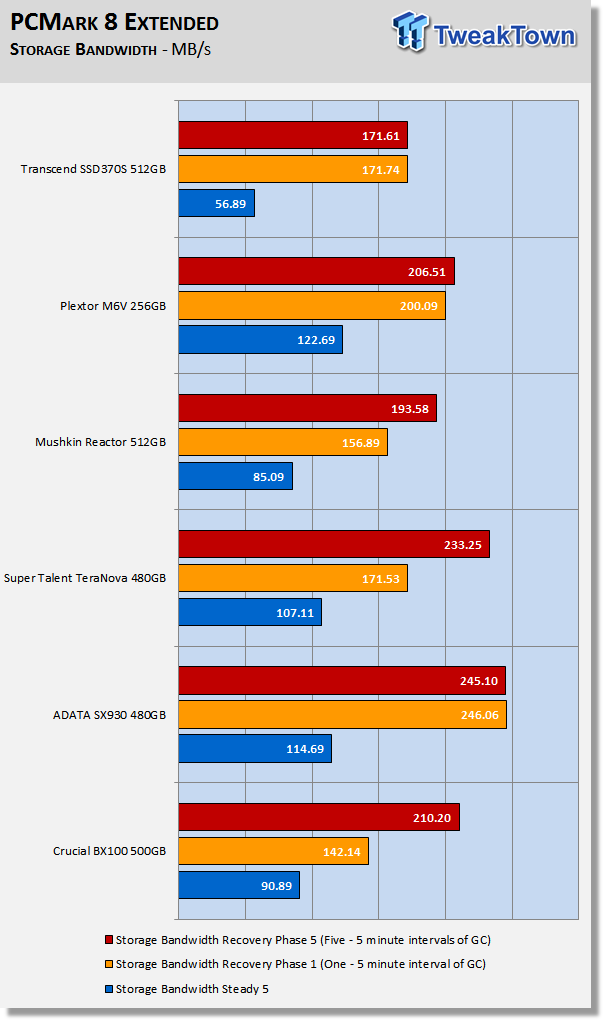
We consider steady state bandwidth (the blue bar) our test that carries the most weight in ranking a drive/arrays heavy workload performance. Performance after Garbage Collection (GC) (the orange and red bars) is what we consider the second most important consideration when ranking a drives performance. Trace-based steady state testing is where true high performing SSDs are separated from the rest of the pack.
At Steady 5, the 370S under performs in comparison to the rest of the drives in our test pool. After one five minute interval of garbage collection, the 370S is able to outperform three of the six drives in our test pool. After 5 five minute intervals of GC, the 370S is outperformed by all of the drives in our test pool.
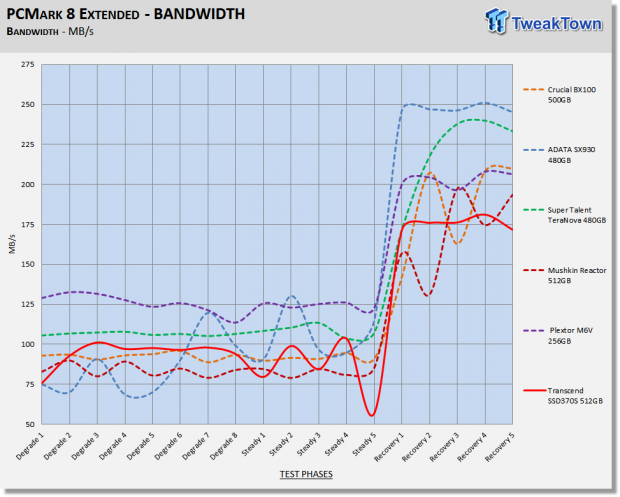
We chart our test subject's storage bandwidth as reported at each of the test's 18 trace iterations. This gives us a good visual perspective of how our test subjects perform as testing progresses. This chart sheds a little more light on how the 370S performs as it progresses through the testing phases. Here we can see the 370S does actually outperform the Reactor and BX100 for the most part in a steady state.
Total Access Time (Latency)
We chart the total time the disk is accessed as reported at each of the test's 18 trace iterations.
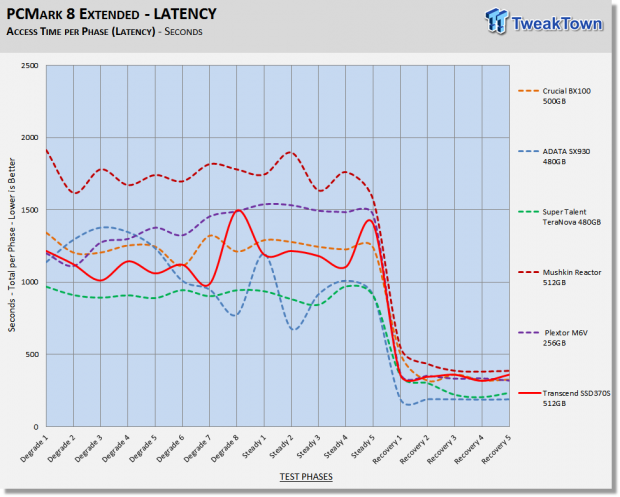
Disk Busy Time
Disk Busy Time is how long the disk is busy working. We chart the total time the disk is working as reported at each of the tests 18 trace iterations.
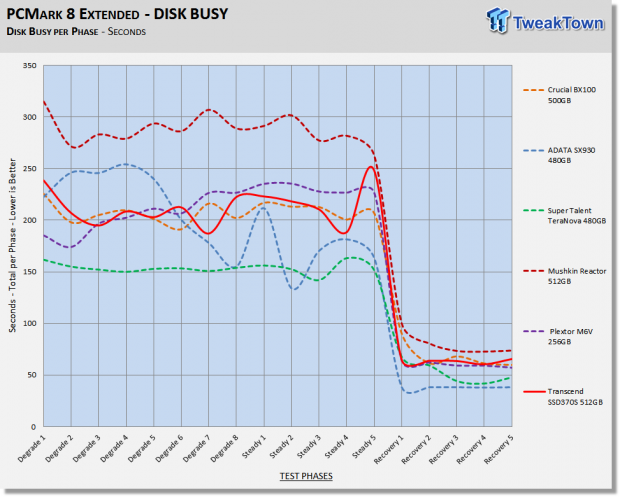
When latency is low, disk busy time is low as well.
Data Written
We measure the total amount of random data that our test drive/array is capable of writing during the degradation phases of the consistency test. Pre-conditioning data is not included in the total. The total combined time that degradation data is written to the drive/array is 470 minutes. This can be very telling. The better a drive/array can process a continuous stream of random data, the more data will be written.
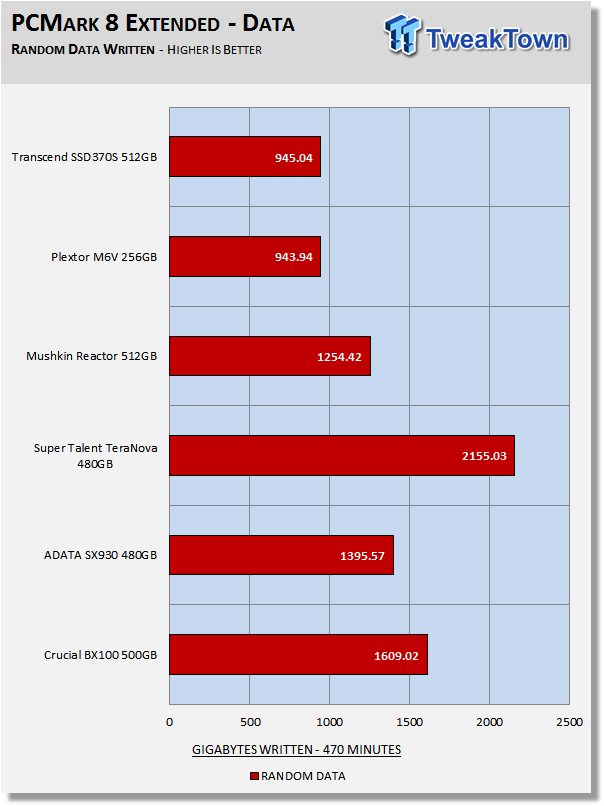
Combined read/write latency, capacity and overprovisioning are the biggest factors that determine the outcome of this portion of the test. The M6V is capacity handicapped, but still manages to write the same amount of random data as the 370S in the same amount of time. The TeraNova has two advantages - 20nm flash and a healthy dose of overprovisioning.
Benchmarks (Secondary Volume) - 70/30 Mixed Workload
70/30 Mixed Workload Test (Sledgehammer)
Version and / or Patch Used: Iometer 2014
Heavy Workload Model
This test hammers a drive so hard we've dubbed it "Sledgehammer". Our 70/30 Mixed Workload test is designed to simulate a heavy-duty enthusiast/workstation steady-state environment. We feel that a mix of 70% read/30% write, full random 4K transfers best represents this type of user environment. Our test allows us to see the drive enter into and reach a steady state as the test progresses.
Phase one of the test preconditions the drive for 1 hour with 128K sequential writes. Phase two of the test runs a 70% read/30% write, full random 4K transfer workload on the drive for 1 hour. We log and chart (phase two) IOPS data at 5-second intervals for 1 hour (720 data points). 60 data points = 5 minutes.
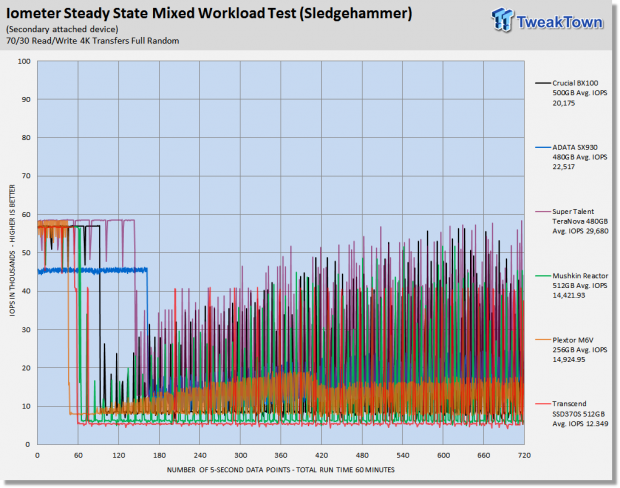
What we like about this test is that it reflects reality. Everything lines up, as it should. Consumer drives don't outperform Enterprise-Class SSDs that were designed for enterprise workloads. Consumer drives based on old technology are not outperforming modern Performance-Class SSDs, etc.
Even though this chart is very hard to read because of the performance variability common to SM2246EN powered drives, the 370S is clearly delivering the lowest performance of the bunch.
Maxed-Out Performance (MOP)
This testing is just to see what the drive is capable of in an FOB (Fresh Out of Box) state under optimal conditions. We are utilizing Windows Server 2008 R2 64-bit for this testing. Same Hardware, just an OS change.
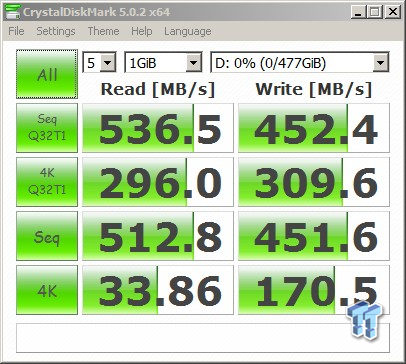
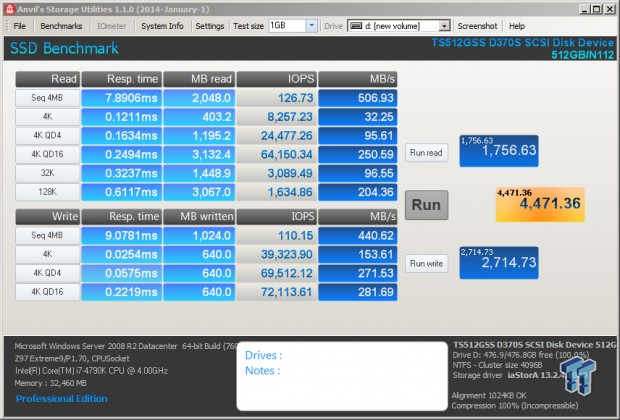
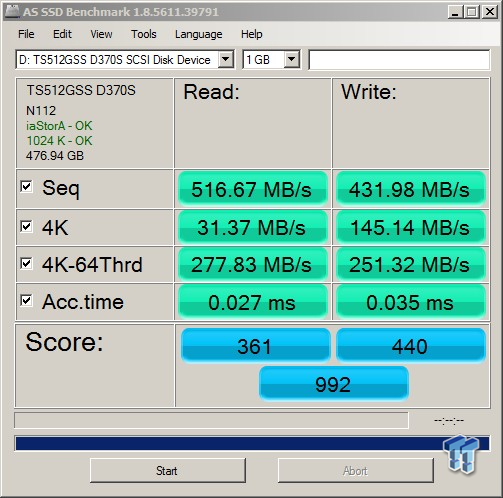
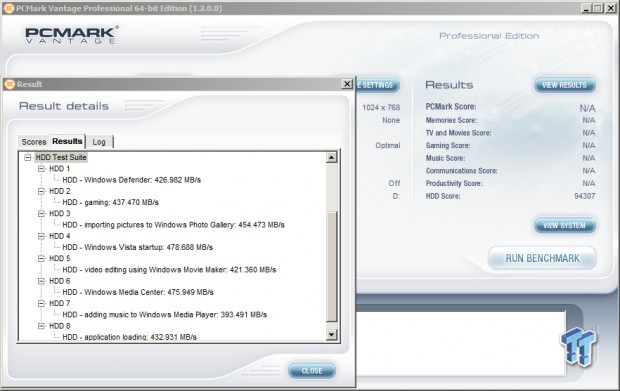
Final Thoughts

We are satisfied with the SSD experience that the 370S delivers; for the most part, the 370S performs as well as similarly configured competing drives. Transcend offers the SSD370S as a complete package by including a 2.5" to 3.5" adapter and cloning software. We have mixed feelings as to exactly how much value this adds to the drive. The adapter, for example, may be something some users will benefit from, but most cases already have native 2.5" drive accommodations.
The included cloning software is great for first time users, but there is freeware that can do the same job if you know where to find it. We don't feel that the included bundle adds much value to the drive for the majority of users.
That brings us more importantly to the cost of ownership. Transcend's SSD 370S 512GB SATA III SSD is currently retailing for around $175. $175 is on the upper end for most SATA III SSDs of similar capacity on the market today. This would not be a problem for an MLC drive that delivers top notch performance, but the SSD370S is an average performer at best. We feel the SSD370S is overpriced for the performance you get. The value add of a $5 adapter and cloning software is not enough in our opinion to make up for overpriced average performance.
Pros:
- MLC Flash
- Adapter Bracket
- Full 512GB Capacity
Cons:
- Average Performance
- Overpriced

